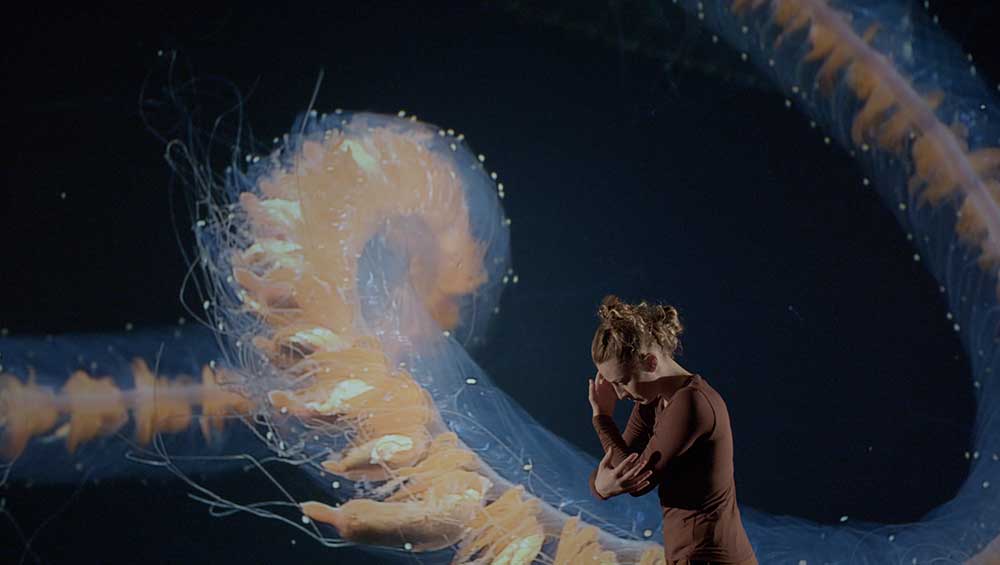
Emma Critchley: Soundings. Presented in partnership with Attenborough Centre for the Creative Arts.
Attenborough Centre for the Creative Arts, University of Sussex
16-23 May 2025
Tate St Ives
24 May – 5 October
by NICOLA HOMER
Emma Critchley (b1980) uses sound, photography and film to create works that investigate humanity’s connection with the underwater environment. An alumna of the Royal College of Art in London, she has exhibited internationally. In 2020, the artist created a soundscape on underwater acoustic pollution in collaboration with international scientists, the British Antarctic Survey and the California Ocean Alliance. The following year, she exhibited a film installation in the Italian Pavilion of the Venice Architecture Biennale.
Soundings, in which she investigates the complex issue of deep-sea mining through film, sound and dance, launched at the John Hansard Gallery in Southampton this year before travelling to the Attenborough Centre for the Creative Arts as part of the Brighton Festival. Now the artist has a show at Tate St Ives in Cornwall, which will move later this year to Quay Arts on the Isle of Wight. The exhibition, which includes a three-screen video and sound installation as well as some live performances, is supported by the Attenborough Centre for the Creative Arts, the John Hansard Gallery, South East Dance and Tate St Ives with public funding from the National Lottery through Arts Council England.
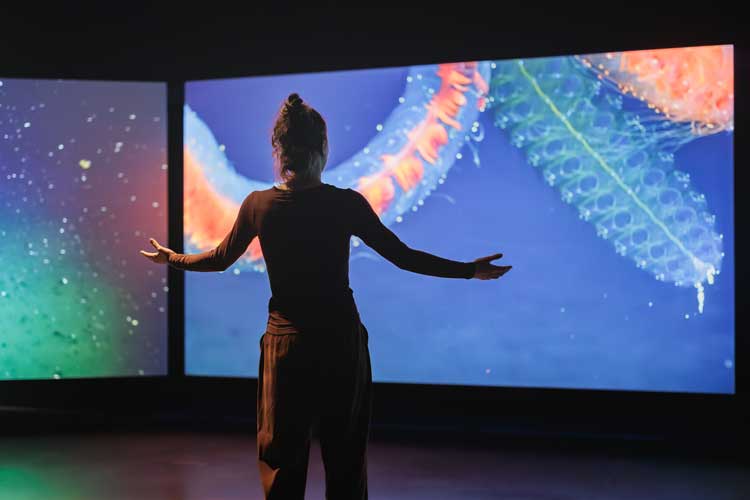
Emma Critchley: Soundings, Live Performance, John Hansard Gallery, 2025. Courtesy the artist. Photo: Nosa Malcolm.
The premise for Soundings is the deep-sea mining driven by the quest for rare earth minerals, which are purported by the mining companies as important in the transition to green energy. Deep sea mining of the high seas is a new extractive industry that hasn’t yet started, but it is the subject of controversy, and the UK and the EU have voiced concerns about its environmental impact. The clock is ticking down for a two-year roadmap outlined in 2023 to finalise the mining code that will define international regulations governing operations. Later this year, the International Seabed Authority, an autonomous international organisation of 169 member states and the EU, established in 1994, following the 1982 United Nations Convention on the Law of the Sea, is expected to meet to finalise those regulations. The authority implements the principle that the seabed and its resources in areas beyond national jurisdiction is the common heritage of humankind.
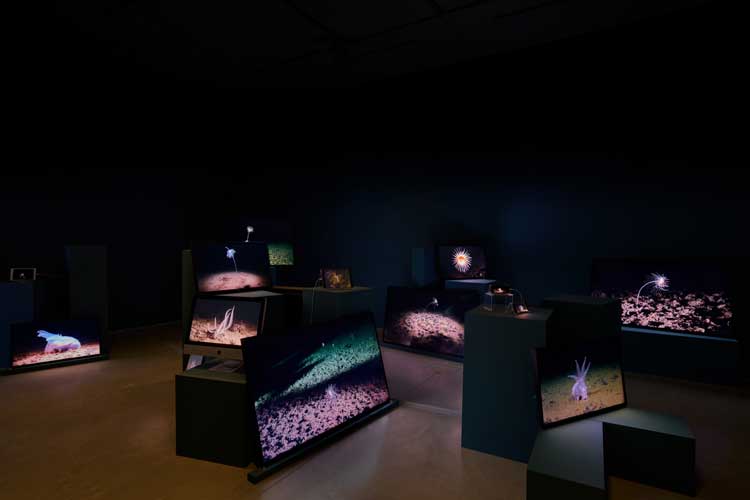
Emma Critchley: Soundings. Installation view, John Hansard Gallery, 2025. Courtesy the artist. Photo: Reece Straw.
At the Attenborough Centre for the Creative Arts, part of the University of Sussex, I visited the show on the first official day of opening. As I watched Soundings, a live dance performance accompanied the installation in a capacious auditorium. The movement was created in collaboration with the choreographer Siobhan Davies. During the Tate St Ives exhibition, you can see live performances on select days. The installation focuses on mining for minerals from the seabed and its environmental, geopolitical and cultural impacts. The piece explores the importance of the deep ocean to humanity and its role in climate regulation in sounds layered over the video. Reference points include international treaties on climate change –the Paris Agreement, signed in 2016, and the Montreal Protocol of 1987 – which aim of regulating the use of chemicals contributing to the depletion of the ozone layer. Soundings also references the UN General Assembly in 1967, when a diplomat made a speech proposing the resources of the oceans were “the common heritage of mankind”, the installation suggests the need for equitable governance of the deep seabed for all humankind.
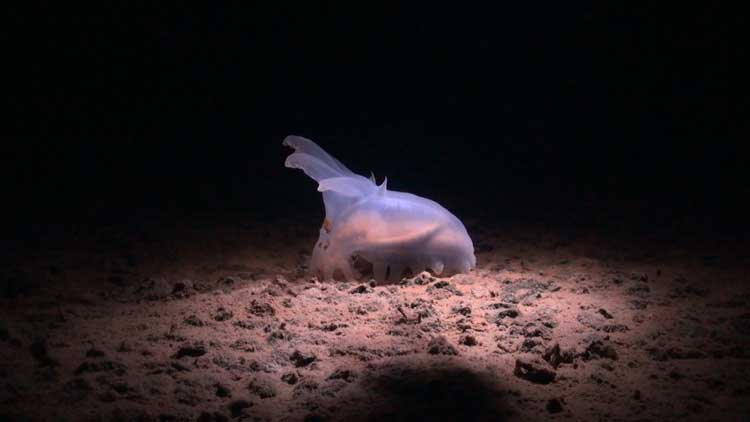
Emma Critchley: Soundings. Film still, 2024. © The Artist.
This work illuminates the connection between humanity and the deep ocean through multiple perspectives, from the voices of activists and lawyers defending the ocean against mining to the movements of underwater creatures, pictured in footage of the seabed, gathered by remotely operated vehicles. The film presents beautiful scenes from Scotland and Indonesia, suggesting the international importance of this pressing issue: people are pictured with objects of significance. The live performance drew fascinating parallels between human and marine life as a dancer reflected on movements of sea creatures in footage of the seabed. With pioneering maps of the seabed by the oceanographic cartographer Marie Tharp, and images of flora and fauna, the film highlights the challenges of understanding the deep ocean and the value of the seabed in architectural and artistic dimensions in terms of the meanings that may accrue to the landscape.
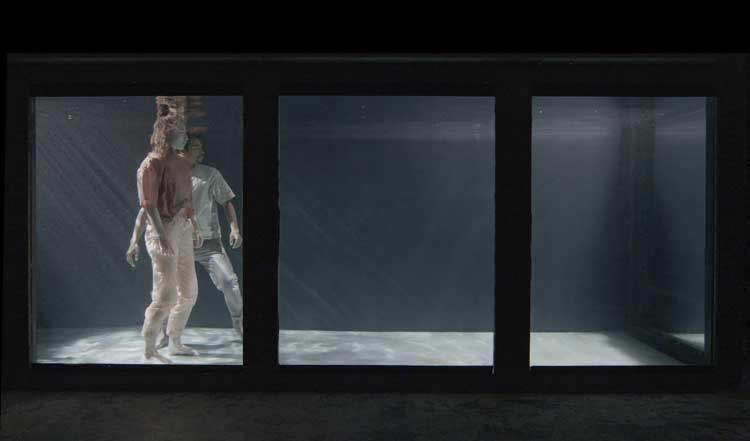
Emma Critchley: Soundings. Film still, 2024. © The Artist.
The film portrays people making their way slowly underwater, calling to mind images of astronauts moving in slow motion in space. The image is analogous to a moon landing – one small step for humankind. The work suggests the seabed is like the surface of the moon for its mystery. The footage of robots absorbed in space exploration underlines this impression. The voices of people layered over the video are thoughtful additions to the work. One actor suggests an analogy for a cave of gold, highlighting the mineral treasures beneath the surface. The sound fades to a low hum as the voices disappear. The quiet ending forms a counterpoint to the song of an elder from a coastal community in Scotland, which sounds like a lament to the ocean, an expression of a changing way of life. This adds an artistic dimension to the video installation, which is part-anthropological investigation and part-nature documentary.
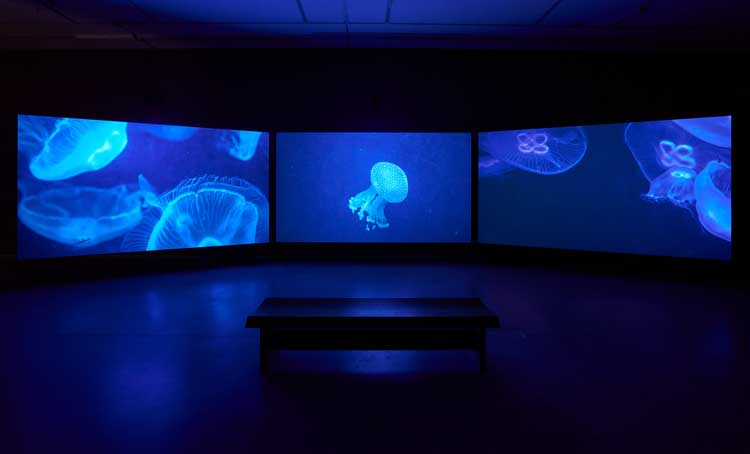
Emma Critchley: Soundings. Installation view, John Hansard Gallery, 2025. Courtesy the artist. Photo: Reece Straw.
At the Attenborough Centre for the Creative Arts, the three-screen installation was framed by text-based work. On display was a rolling transcript on a debate from a meeting of the International Seabed Authority, where member states discussed the international regulations for deep-sea mining, amid calls for a moratorium on activities. In addition, there was a public letter from the Republic of Nauru, a tiny island in the South Pacific Ocean, the future of which is threatened by climate change, pledging its intention to apply to mine the seabed for mineral riches to power the transition to green energy. An open letter entitled Rights of the Deep (2024), co-authored by the artist with marine scientists, legal scholars and activists, offered reflection on humanity’s connection with the deep ocean, and stressed the need for its environmental protection. Ten years after the Paris Agreement was adopted at the UN Climate Change Conference (Cop21), the letter that the artist co-wrote with international collaborators will be presented at the One Ocean Science Congress, ahead of the UN Ocean Conference, where the world’s leaders will gather to discuss the future of the global ocean this month in Nice.
• Emma Critchley: Soundings will then be at Quay Arts, Newport, Isle of Wight, from 10 October to 19 December.